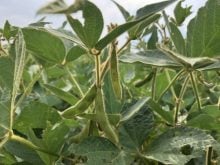MarketsFarm — There remained little doubt that Brazil’s corn safrinha (second) crop will be smaller than initially anticipated, according to Dr. Michael Cordonnier of Soybean and Corn Advisor Inc.
He chalked up most of that due to conditions being too dry and too wet for the planting of Brazil’s soybean crop, depending on the region.
“The situation in east-central and northeastern Brazil continues to be below-normal rainfall and its has slowed down the soybean planting,” Cordonnier said. “In southern Brazil, it’s just the opposite. They’ve had very heavy rains. It’s like unbelievable amounts of rain in September and October.”
Read Also

U.S. grains: Soybeans rise on China demand hopes; corn and wheat rebound
Chicago Board of Trade soybean, corn and wheat futures rose on Monday on signs of progress towards the end of a record-long U.S. government shutdown, along with expectations of a revival of U.S. soybean exports to China, analysts said.
He said there has been a few dry days so far in November, but more rain was forecast. So far, soybean planting throughout Brazil was about halfway complete, 14 points behind the year ago and 10 below the five-year average.
“Everybody says it’s going to be planted late. It’s just a matter of how late,” Cordonnier stated, pointing out that some of the soybean crop was replanted, such as in Mato Grasso where’s estimated to be 10 per cent.
Overall, corn planting in Brazil was less than one-quarter finished, the same pace as a year ago but nine points back of the five-year average, he said.
Faced with delays, Brazil farmers might not plant as much corn given prices stood at the breakeven point. Cordonnier also pointed to reduced sales of corn seed and fertilizer following last year’s below average safrinha crop. He suggested cotton or more soybeans were among farmers’ options.
He explained the safrinha corn is planted in two phases, with the first being September-October, and the rest in December. On average, 40 per cent of the corn is planted in the first phase, but he placed the current pace at 25 per cent. With that, he said farmers might try to plant more than usual in the second phase.
The U.S. Department of Agriculture attaché in Brazil chopped five million tonnes from its previous call of 130 million.
In light of Brazil’s current weather extremes, there’s some hope for a good soybean crop in central region, but Cordonnier said meteorologists stressed the erratic nature of the current El Nino will vary a great deal. He added there’s a chance for dryness during December and January, just when the pods would be filling.
“That would be very detrimental,” Cordonnier stressed.
He said projections coming out of Brazil have already trimmed initial expectations, but nothing extreme as of yet.
“If the weather doesn’t improve, it might be more than just trimming,” Cordonnier said.
Last month, USDA projected Brazil’s 2023-24 soybean production to hit a record 163 million tonnes.
— Glen Hallick reports for MarketsFarm from Winnipeg.















